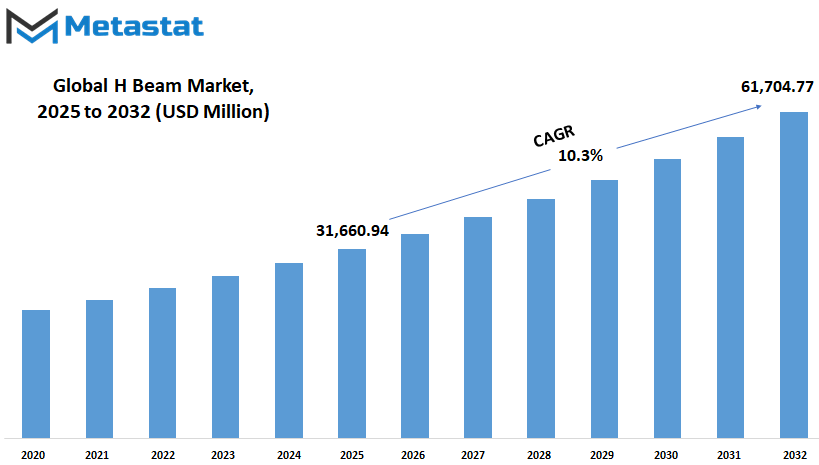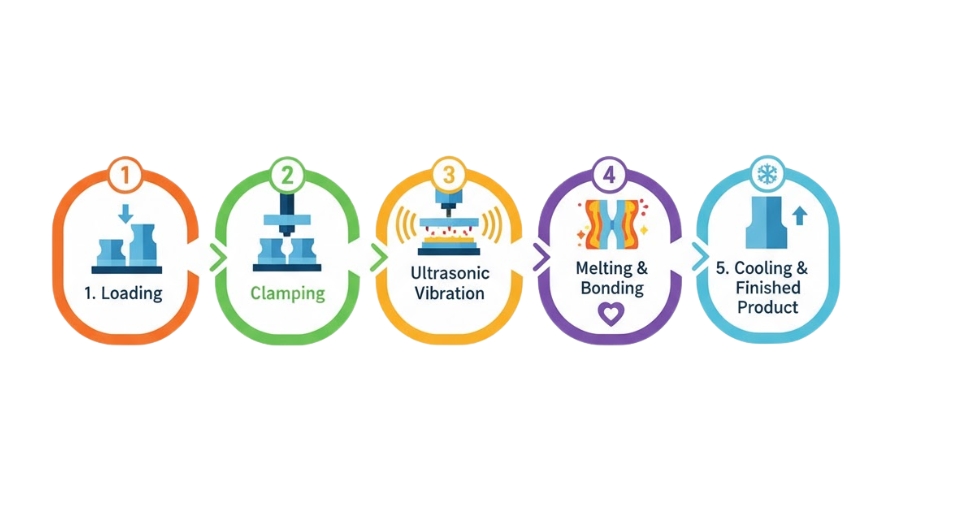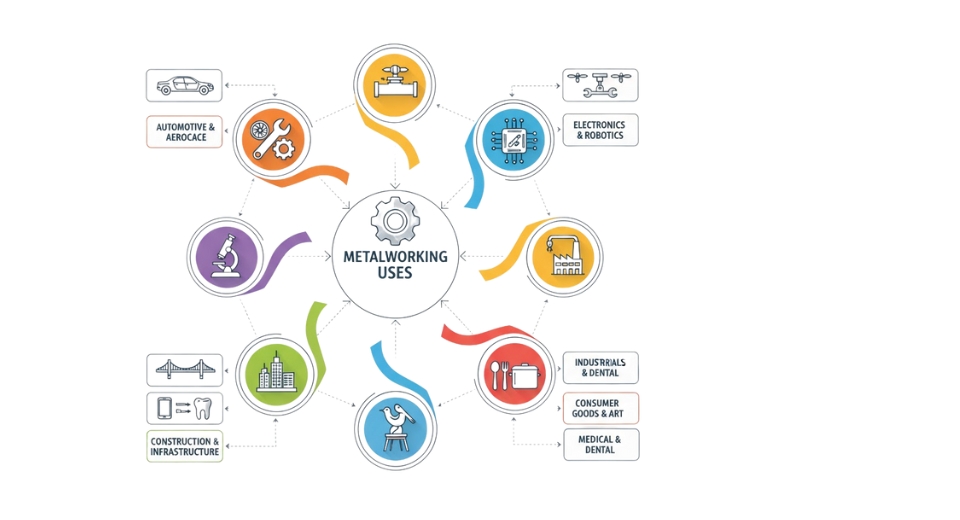MARKET OVERVIEW
It is currently speculated that the Global H Beam market will grow in its significance in the face of modern construction and infrastructure. H beams are those beams whose cross-section resembles an H. They hold great strength and bearing capacity and thus find certain applicability within structural engineering, thus becoming an important raw material for construction.
This raw material covers pretty much all the other markets for residential, commercial, and industrial constructions as well as shipbuilding and manufacturing. As advancements demand more long-lasting and high-performance structural materials, the Global H Beam market will witness the evolution of engineering practices and innovative applications.
With robust production technology and excellent quality standards, the Global H Beam market meets every need in construction and infrastructure environments in the world. H-beam production guarantees consistency in strength and high precision by advanced hot-rolling and welding processes. It has all kinds of sizes and specifications for its application range extending from heavy-duty industrial frame to lightweight residential constructions. Such adaptability makes them a basic building block for contemporary architectural and engineering solutions.
As urbanization picks up and nations spend their way into large-scale infrastructure projects, the Global H Beam market will spread its wings across developing and developed regions alike. Heightened investments in transport networks, high-rise buildings, and industrial installations will require structural materials that are reliable and cost-effective. Opportunities for the market also lie beyond time-tested construction technologies and into the renewable energy installations and modular construction techniques.
The Global H Beam market shall also be seeing developments made in materials innovation and production efficiency. Manufacturers will focus on producing alloys that are high-strength, light weight, and environmentally friendly and sustainable in their production methods, striving to comply with environmental regulations and controlling carbon footprints. Automation and digitalization within production will keep precision up and productivity high; the market on the other hand must stay in line with changing industry parameters and technological improvements.
Issues arising from geopolitics, which affect global trade dynamics, will likely impact the distribution and pricing of H beams, as most big players in the markets grapple with supply chain difficulties. The supply of raw materials such as steel will be directly impacted by the costs of energy used in manufacturing. The initiation of strategic alliances between manufacturers and construction companies is expected to foster product innovation and customization-aligned solutions that will strengthen the relevance of this market in the global developmental initiatives.
Global H Beam market is estimated to reach $61,704.77 Million by 2032; growing at a CAGR of 10.3% from 2025 to 2032.

GROWTH FACTORS
The Global H Beam market is expected to grow significantly in the coming years, thanks to many factors that reflect changing demands and innovations in construction and infrastructure development. In fact, due to their promising strength, durability, and load-bearing capabilities, these beams have been critical components for work in a number of industries. As urbanization happens, and with more modern construction techniques, the tend toward needing reliable, high-end structural materials such as H Beams will increase. This demand can be assumed to spur the market and open doors for manufacturers and suppliers across the globe.
The upsurge in investments on the construction or upgrade of infrastructures is among the factors expected to push the growth of the Global H Beam market. Various governments and several local private companies are focusing on the respective projects of constructing highways, bridges, commercial spaces, and even housing complexes. With the stability and load-bearing capacity exhibited by the H Beams, these ensure an appropriate choice for such gigantic projects.
Moreover, steady construction also fuels the demand for H Beams since their designs usually allow reduction in using unnecessary materials, while ensuring structural integrity under a more sustainable and energy-efficient trend.
An important driving force behind the market is rapid industrialization across the developing parts of the world. Manufacturing plants are now building more logistics and warehousing centers, which need sturdy frameworks; H Beams offer an ideal solution for this. Its property of withstanding high stress and supporting huge machinery makes it indispensable for industrial construction. The building of smart cities, as well as modernized infrastructure projects, add to the advancement and demand for high-end materials in construction, which further enhances favorable climatic conditions for the Global H Beam market.
These factors may, however, slow the growth of the market. All kinds of fluctuations in the prices of raw materials such as steel can cause a great variation in production costs and change pricing strategies. Also, environmental concerns related to the processes of steel manufacturing would entail strict regulations with subsequent increased costs for producers. The availability of alternative materials with comparatively lesser environmental impact can also pose competition, influencing growth in the market.
But looking into the future, there are very good chances for the Global H Beam market. New forms of manufacturing processes such as lightweight, high-strength beam designs might promote efficiency and application reach. The rising focus on green building certification and sustainable practices is likely to enhance uptake of these 'green' H Beam solutions. Additionally, urbanization within the growing economies will increase significantly in the future, fueling massive potential for growth in this market.
The Global H Beam market seems to be on an incremental growth pattern because of infrastructure development, industrialization, and technological advancements. There exist some challenges to be solved; however, these would be beneficial grants that cater for overall market growth in the future.
MARKET SEGMENTATION
By Type
The Global H Beam market has high chances of magnificently growing in the near future, with the demand for H Beams rising in various industries. H Beams are known for strength and durability, being widely used in construction, infrastructure development, and heavy engineering projects. The H shape grants them a very high load-bearing capacity, which is a sacrosanct factor for preferring them when it comes to large-scale structures.
Therefore, as the world continues to concentrate on urbanization and modernity, these reliable and high-quality building materials will keep being in demand, thus H Beams. In addition, the Global H Beam market is mainly affected by increasing segmentation by type, which includes Hot-rolled H Beams and Welded H Beams. Both types possess unique advantages and can be utilized for different applications. Hot-rolled H Beams are produced in the process of heating steel and then shaping it, gaining strength, uniformity, and resistance to wear and tear.
These H Beams are selected more for high-scale constructions as they withstand heavy loads and exposure to harsh environmental conditions through the consistency of shape and dimensions, amenability to processing, construction time, and cost reduction.
Contrarily, Welded H Beams are made by welding steel plates together to create the H shape. This process allows for more customization with regard to size and design, which defines these beams' use in specialized projects where standard sizes may not meet certain requirements. Therefore, Welded H Beams provide adaptability and flexibility, both vital elements for projects that have unique demands in terms of structure. Although they would need more time and work for production compared to hot-rolled beams, Welded H Beams, which can be customized to exact specifications, are therefore a very valuable option in custom construction work.
As the industries are advancing toward application and sustainable practice, it is likely that innovations will find their ways into fast-tracking the Global H Beam market. The kind of environmentally friendly production techniques and market-conducive material scenarios will determine where the market is headed. The escalation in energy-efficient construction and recycled material use will put H Beam manufacturing processes under an ever-increasing environmental conscience. In addition, advances in design and engineering shall further enhance the strength, weight, and efficiency of these beams, cementing their further position in the contemporary infrastructure.
Overall, the Global H Beam market is set on a steady growth path as the construction sector keeps maturing and versified into the demand for strong and versatile building materials. This market will continue to forge the future built environment with the dual growth of Hot-rolled and Welded H-Beams.
By Application
The Global H Beam market anticipates a steady development in the years to come, with applications in several different industries. They are strong and durable entities that are known to serve construction purposes and infrastructure development. This would actually increase the demand for these steel beams as modernizing and expanding countries require them. Heavy-duty load bearing combined with stability would always bring their necessity in several large projects. With technological advancements, rising urbanization, and a growing need for sustainable construction materials, the future of the Global H Beam market will be influential.
But not only this, advancement in cities toward high-rise buildings will be pushing the demand for these materials upward as cities grow and more high-rise buildings are constructed. This increased requirement of H beams cannot be denied because of their reliability and durability for constructions. Such h beams provide the amount of strength needed to support the construction of these buildings and have been highly preferred by architects and civil engineers.
When designing modern buildings that's sustainability, this has to come about by increased utilization of H beams since they are also recyclable and can be used repeatedly without loss of quality. Thus, this characteristic is going to be one of the aspects concerning future construction methods.
Much H Beam construction is seen for the development of roads and bridges. Due to the growing demands of transportation on infrastructure, many projects for expansion and upgrading have been implemented all over the worldwide countries. H beams will provide that kind of durability to construct bridges and roadways which last longer and remain safe and stable under extremely heavy traffic and severe weather conditions. As the governments invest in the betterment of public infrastructure, the H beam demands in this sector will surely increase in the near future.
Heavy machinery manufacturing is another area where the importance of H beams lies. Such pressure and shape should not get disturbed. Thus, they can be used to construct large machines and industrial equipment. As the era of technology progresses and tends to make industries more automatic, there is a driving force for these materials. This field will see more demand for H beams.
H beams are used in the railway industry to build tracks, stations, and supporting structures. The development of high-speed rail networks in different parts of the world and the modernization of existing systems call for high-strength and durable materials. These attributes are the necessity of h beams as they provide the strength needed to construct structures that can support heavy trains while providing stability for the infrastructure so that it can safely transport passengers.
H beams are also commonly used in other sectors, such as marine construction and designated international projects. As offshore development and shipbuilding expand, the demand for more materials will thrive. H beams will provide the strength and resistance that such harsh environmental setting will require to ensure long-lasting performance.
By End-Use
In the coming years, the market for Global H Beam will witness significant growth which will be propelled by the growing demand across various industries. These h beams are of great importance in almost all large-scale projects. Because of their characteristic high loading-bearing properties, these beams are used in the heavy construction as well as industrial applications. With the development of many industries, the requirement for durable and reliable structural components will also rise, much like H beams are.
Construction as one important market driving this category. Urban infrastructure is a big-time investment in high-rise complexes, bridges, and commercial spaces and is dependent on H beams to ensure stability and strength in applications. An increase in these would definitely be created as a result of further investments by countries in smart cities and modern transportation networks. Existing projects on green buildings can very well forward the usage of such materials as high-quality H beams which are always symbolized by efficiency and durability.
The oil and gas sector do have a decent impact on the future of the H beam market as well. The energy demand of the world is increasing, which will create more and tougher basic structures, exploring, and producing oil and gas. Construction generally uses H beams for drilling platforms, pipelines, and refineries. It is expected that the size of the H beams would grow more, as industries look for cost-effective and long-lasting materials that could withstand harsh environments.
H beams represent the necessary manufacturing determination of heavy-duty vehicles and industrial machinery in the automotive sector. They hold high strength together with low weight; as a result, heavy-expressive motion tools with significant load handling capabilities are manufactured using these materials. The scope will be much more as the motor industry continues to transform itself into electric and green enabling technologies for the future.
While energy and power will also contribute significantly to the growth of the Global H Beam market, the strength of H beams is essential for all renewable energies-from wind to solar farms; solid foundations and strong support structures would be inevitable. The structures and temporary installations must be rugged enough to withstand the ravages of time and severe weather. As the world moves toward greener energy sources, there will be a higher demand for long-lasting and flexible construction materials in arch types.
Thus, the Global H Beam market witnesses a regular expansion into various sectors. Technology and sustainable development usually form the basis of most industrial applications of H beams. All growths resulting from the market trends indicate that industries work in an evolving demand for durability and performance in infrastructure and manufacturing processes.
|
Forecast Period |
2025-2032 |
|
Market Size in 2025 |
$31,660.94 million |
|
Market Size by 2032 |
$61,704.77 Million |
|
Growth Rate from 2025 to 2032 |
10.3% |
|
Base Year |
2024 |
|
Regions Covered |
North America, Europe, Asia-Pacific, South America, Middle East & Africa |
REGIONAL ANALYSIS
With respect to the growth paths and demand drivers in a given region, the market split is indicative of the world over, namely, North America, Europe, Asia-Pacific, South America, and Middle East & Africa. Each of these areas has its own economic conditions, industrial growth, and infrastructure projects that play a vital role in shaping the future of the H Beam market. H Beam requirement for construction and engineering will increase significantly as the industries continue to grow and urbanization sets in.
Currently, the H Beam market shows some promise in developing in North America, namely, in the United States, Canada, and Mexico. The U.S. holds a robust construction environment and invests in commercial and retail residential development, making it suitable for high demands. Furthermore, with focuses on infrastructure modernization in Canada and the tooling programs of the growing industrial sector in Mexico, the H Beam market expansion in this region will also benefit.
Europe is indeed beset by the clash of established against emerging opportunities. Nations such as the United Kingdom, Germany, France, and Italy offer have construction industries, but their increasing focus on sustainable building practices will likely shift thereby increasing the H Beam application. As such, the market will be drawn toward advanced materials and innovative building methods aimed at constructing green and energy-efficient structures, thus increasing the demand for quality steel beams in the region.
The rapid urbanization and industrialization have placed Asia-Pacific in a prominent position on the world H Beam map. Large-scale infrastructure measures and rapidly growing economies will drive the count in market demand in the likes of China and India. Japan and South Korea are expected to continue to pioneer innovation and raise quality standards for beam production thanks to their advanced engineering know-how and technological expertise. Demand for strong and reliable building materials will always find room for growth across the region, thanks to the establishment of smart cities and modern transportation networks.
Given the construction activity and economic development, the South America market led by Brazil and Argentina offers opportunities. As urban areas expand along the lines of government investments in infrastructure, demand for durable and economically viable materials like H Beams will grow. The development might be slow, but this growth would have a steady hand, nurtured by a focus on modernization.
Ongoing infrastructure projects and urbanization in different areas provide the lucrative market for H Beam needs in this sector. The larger investments in a diversified portfolio of construction and industrial ventures by countries including the GCC nations, Egypt, and South Africa, support H Beam in gaining demand through commercial and residential projects as modernization and diversification figure in the development of these countries.
In future, the global H beam market keeps growing as a result of regional developments and demand for construction change. All measures will, however, favor countries wherein the pigmentation in H beams appears.

COMPETITIVE PLAYERS
Key players operating in the H Beam industry include Nippon Steel Corporation, The Warren Company, JFE Steel Corporation, POSCO, Henan Baowu Steel Co., Ltd., Beyond Steel, Nucor Corporation, YAMATO STEEL Co., Ltd, HBIS Group Co., Ltd., SENLISWELD, Tung Ho Steel, YEOU CHYR
H Beam Market Key Segments:
By Type
- Hot-rolled H- Beams
- Welded H- Beams
By Application
- Building
- Road & Bridge
- Heavy Machinery
- Marine
- Railway
- Others
By End-Use Industry
- Construction
- Oil & Gas
- Automotive
- Shipbuilding
- Energy & Power
Key Global H Beam Industry Players
- Nippon Steel Corporation
- The Warren Company
- JFE Steel Corporation
- POSCO
- Henan Baowu Steel Co., Ltd.
- Beyond Steel
- Nucor Corporation
- YAMATO STEEL Co., Ltd
- HBIS Group Co., Ltd.
- SENLISWELD
- Tung Ho Steel
- YEOU CHYR
WHAT REPORT PROVIDES
- Full in-depth analysis of the parent Industry
- Important changes in market and its dynamics
- Segmentation details of the market
- Former, on-going, and projected market analysis in terms of volume and value
- Assessment of niche industry developments
- Market share analysis
- Key strategies of major players
- Emerging segments and regional growth potential








 US: +1 3023308252
US: +1 3023308252






